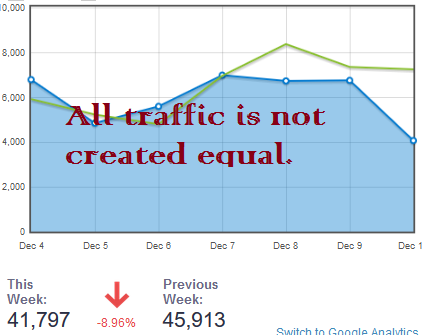Your cart is currently empty!

Reaching Local Customers
Do you check your website’s traffic? If you look at analytics at all, this is probably the thing you check. You might look at the Audience Overview report on your Google Analytics dashboard, check your WordPress Jetpack stats, or glance at an automatic report. If you see that your traffic is about the same or increasing a bit, you’re satisfied. But are you reaching local customers?
The world has gotten a lot flatter, and many businesses and organizations are now reaching out to potential customers and clients all over the world. Yet there are still plenty of professions that really still depend on local residents. A physical therapist or indeed most medical professionals, a gym or yoga studio, a local restaurant or store — you have a defined service area.
 .
.
If you’re relying on overall traffic data, you might be looking at the wrong information.
Some of your traffic might be customers or potential customers, but some of that traffic might not be relevant.
- Check geography first, but don’t jump to conclusions. Generally speaking, if you work with local people, you should be looking only at local traffic. There are exceptions, though. One of our medical websites saw a lot of traffic from a neighboring state. On further digging, we found that it was a combination of job seekers and parents looking for a doctor for their students at our local university. Both of these groups are valuable traffic for the website. But lots of traffic from Brazil, Russia, and other spam traffic hotspots is probably not of any value to your business at all. If you’re providing useful information to people who don’t happen to be in your area, that’s not a problem. You don’t have to pay workers to answer questions or keep the lights on for those browsing visitors from South Dakota. However, you might want to use more targeted local language and information to encourage local people to visit more.
- Filter out the bots and your team. Are you seeing yourself, your staff members, or your web team in your analytics? Their behavior can give you a false impression of how your customers and leads behave at your website. Filter them out in the admin area of your Google Analytics account. If information on how your team uses the website is important, just set up separate segments or views. You should also filter out bots. They won’t become patients, clients, or customers, so their visits are unimportant.
- Compare visitor behaviors. Setting up segments for people in your immediate area and in neighboring towns or states that you’d like to reach can give you a better idea of how the different groups like to use your website. If visitors from your service area are more likely to contact you when they come via social media, you’ll want to invest more resources into social media… and you might not know that if you don’t set up segments.

Sometimes people hesitate to use filters and segments in analytics because they don’t want to see a drop in traffic (or they don’t want their boss to see that drop). If you’re seeing visits from people — or machines — that aren’t really your customers, though, you’ll be making decisions based on inaccurate data. Steel yourself and clean up the data collection so you’ll be able to make informed decisions that propel you toward your goals.
You can still be excited about the number of people who visit you, but make sure your website is actually serving your local customers.

Leave a Reply